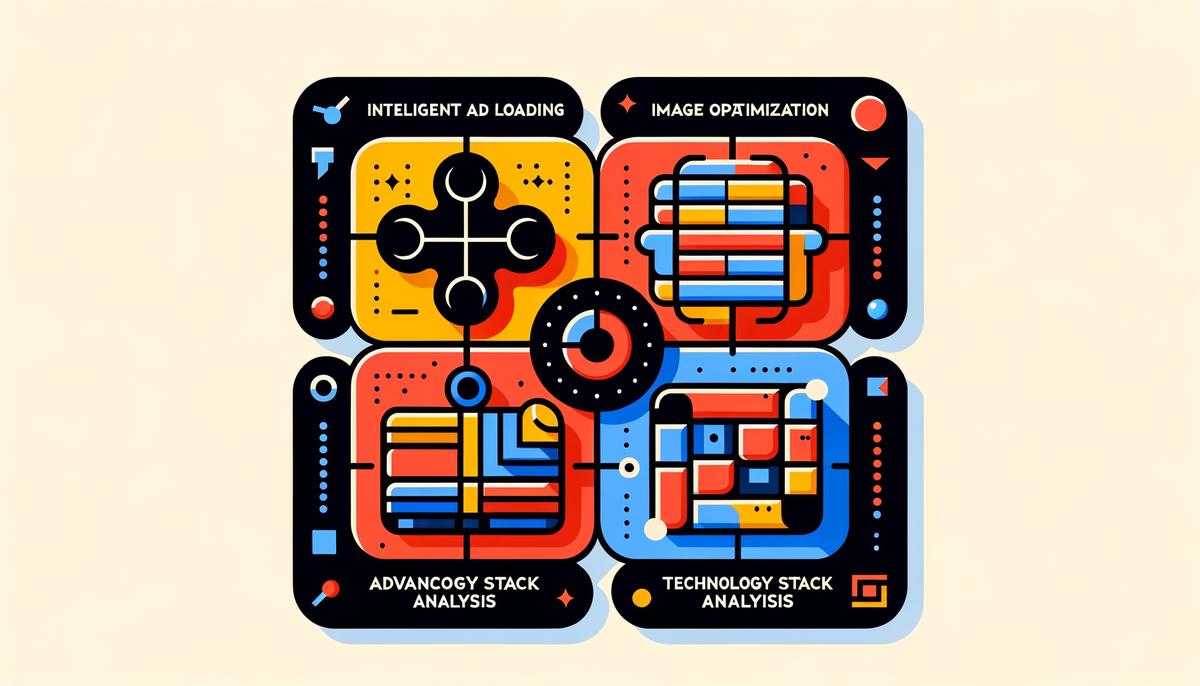Ezoic Leap Overview
Ezoic Leap is a tool set designed to improve website speed while optimizing ad placements. It streamlines various optimization technologies to address hindrances to site performance caused by ads and other heavy elements.
Leap's primary capability is reducing the load time impact from ads. It brings intelligent ad loading, where only essential ads load in alignment with content rendering, not delaying overall page visibility for visitors.
Another key feature is automated image optimization. Leap compresses and resizes images according to the viewer's device specifications, maintaining visual quality while discarding unnecessary data.
Ezoic uses advanced caching strategies to serve content from closer geographical locations to the user, minimizing data fetching time across long distances. Caching involves saving static versions of content to reduce server processing time per request.
Leap analyzes a website's existing technology stack, recognizing plugins, themes, and scripts that negatively affect site pace. It suggests proven enhancements based on performance data across numerous Ezoic-powered sites.
While addressing core performance metrics such as First Contentful Paint (FCP) and Largest Contentful Paint (LCP), Leap enables websites to adhere to Google's Web Vitals standards, often resulting in better organic search positions.
Webmasters have observed improvements in loading speeds, bounce rates, and ad viewability post-Leap integration. With faster sites, users tend to stay longer, interact more, and view more pages, creating more ad revenue potential.
Ezoic Leap also simplifies management for website owners by offering holistic solutions under its own optimization protocols, replacing the need for numerous third-party plugins.

Impact on Mobile Performance
Ezoic Leap significantly improves mobile site speed by employing adaptive technologies suited to handling mobile browsing challenges. Automated image compression is particularly beneficial for mobile devices relying on slower cellular data connections. Images load markedly faster, enhancing overall site responsiveness.
Leap's intelligent script execution optimizes how and when JavaScript is executed on a page. In a mobile context, this ensures that scripts essential for user experience load first, while deferring others that could slow down the page. This sequencing contributes to a quicker First Input Delay (FID), a critical metric for mobile user experiences.
Case studies quantify these benefits:
- An independent health blog reported a 45% reduction in mobile load time after integrating Ezoic Leap, translating into a 20% decrease in bounce rate and a proportional increase in page views per session.
- A tech review site experienced a 50% improvement in their LCP on mobile devices, boosting their visibility in search engines.
Ezoic's caching strategies are particularly geared towards mobile users. By optimizing server responses and asset delivery based on the user's device and location, Leap reduces the time it takes for content to become interactive and visible on the screen.
For web publishers navigating the balance between ad revenue and user experience, Ezoic Leap is an attractive solution. It elevates mobile performance metrics, leads to higher SERP rankings, better site stat grades, and more effective ad placements.
Revenue Optimization Features
Ezoic's AI-driven features are groundbreaking in the sphere of advertisement placement and revenue optimization on mobile sites. Its capacity to leverage artificial intelligence to test various ad placements algorithmically pinpoints configurations that generate maximal user interaction without impeding the user experience. This machine learning model operates on continuous feedback loops, analyzing numerous site interactions to fine-tune ad locations in near-real-time.
Ezoic's algorithms evaluate diverse layouts under multiple user conditions, addressing one of mobile optimization's toughest puzzles: varied user contexts. This contextual adaptability means ads delivered via mobile interfaces are not only visually engaging but also contextually positioned for superior viewer resonance, driving up click-through rates.
Layout optimization conducts algorithmic trials across devices, ensuring both visual appeal and functional utility. Ezoic tweaks every pixel to capitalize on engagement opportunities without sacrificing speed or functional layout aspects, ensuring swift and meaningful interactions.
These AI and machine learning environments create a stark contrast with traditional site-wide ad placements, where paradigms may remain stagnant for longer intervals and could become inefficient due to changing viewer trends. With insight into subtle behavioral shifts amongst its traffic, a site leveraging Ezoic can adjust dynamically, resizing, reshuffling, and reconfiguring ads based on content relativity.
Ezoic enables site owners to eschew guesswork inherently associated with ad placement. This translates to retailer and advertiser satisfaction, assuring consumers of an unobtrusive yet commercial site interaction, laying the foundation for higher retention rates and longer visit durations.
With comprehensive feature sets such as intelligent caching and automated image optimization fostering quicker navigation speeds, Ezoic further secures its mark of superiority. These operations translate into direct uplifts in ad conversions by maintaining the balance between keeping a user vested and enticed through optimized ad experiences.
Ezoic's framework equips advertisers with business analytics giving them granular control over campaign expenditure versus actual returns. Reports and dashboards offer real-time breakdowns on what is working, empowering decision-makers to drop unprofitable perspectives swiftly, turning their ad strategies proportionately reactive and considerate to market dynamics.

Compatibility and Integration
Ezoic Leap's integration and compatibility capabilities are crucial for publishers wary of how well this optimization solution might work within the diverse ecosystem of web technologies. Nexus points such as mobile operating systems, web hosts, and content management systems vary significantly in behavior and architecture.
Leap shows notable compatibility with mobile operating systems through its responsive adaptation of content and ads. Leveraging browser nuances, the system effectively customizes ad loading and content display to suit specific platform commons.
Moving to web hosts, Leap exhibits a spectrum of compatibility extensions but isn't without its glitches. Constraints become manifest when applying its caching logic and implementing its CDN solutions. Some issues arise due to configuration controls that each host maintains over their infrastructure.
Content management systems like WordPress, Joomla, and Drupal generally play nicely with Ezoic Leap, courtesy of plugins and specialized integration paths. These CMSs delight in the speeding enchantments so long as the overlays do not collide with peculiar setups or customized deployments managed uniquely by site administrators.
Effective publishing today demands astute choices, and Ezoic has customized Leap to be as seamless and integrating as possible. It's fitted to enkindle mobile responsiveness, solid interoperability with major web technologies, hitched alongside debugging succors ensuring all rounds are covered.

User Experience and Feedback
User feedback about Ezoic Leap emphasizes a broad spectrum of user experiences, ranging from enthusiastic endorsements to cautious skepticism. A prevalent theme among positive reviews is the tangible uptick in site performance and revenue generation. Many publishers commend Leap for its efficacy in optimizing their mobile sites, noting significant improvements in load times and user engagement, which directly correlate to increased ad income.
Critics of Ezoic Leap often focus on the initial complexities of configuring the system and integrating it with existing website setups. Some users have reported challenges with plugin compatibility and slight decreases in customizability, citing instances where default settings within Leap were not entirely aligned with specific site goals or aesthetics.
Despite these configurations and adjustment pains, another trend that resonates in user feedback is the support provided by Ezoic's technical team. Individuals who experienced technical hurdles noted that prompt and efficient support greatly eased implementation challenges.
In cases where publishers praised Ezoic Leap, there were noticeable improvements listed in their Core Web Vitals, seeing substantially higher scores, especially in areas like Largest Contentful Paint (LCP) and First Input Delay (FID)—key indicators of a healthy, performant mobile website as it relates to Google's benchmarks for good user experiences.1
Discussions within Ezoic forums and digital marketing social media groups indicate a consensus about Leap's role in democratizing access to advanced site optimization technologies that were previously accessible mainly to large publishers or those with deep resources.
By facilitating a better balance between display ad revenue and user experience, Ezoic Leap addresses a critical pivot within digital publishing wherein user satisfaction correlates directly to profitability. These perspectives formulate an invaluable asset for Ezoic—constantly refining and calibrating Leap's functionalities to bridge gaps between ad revenue optimization and pristine user experiences.
- Ezoic. Improve your Core Web Vitals with Ezoic. Accessed March 10, 2023.



